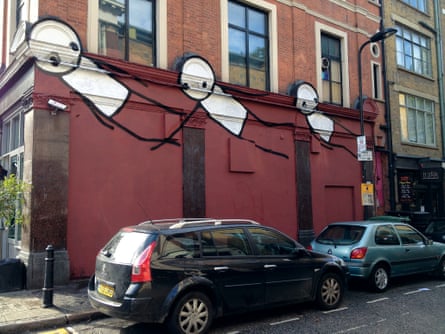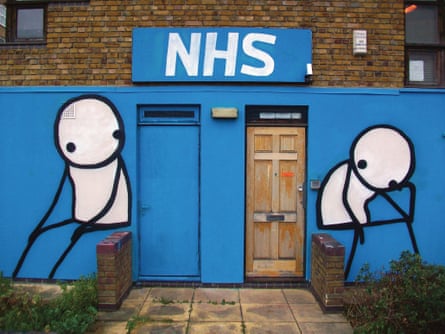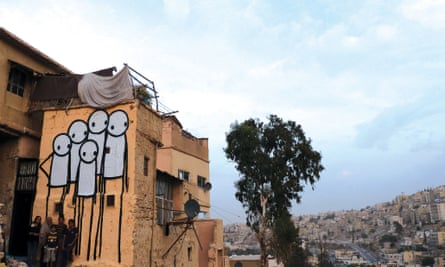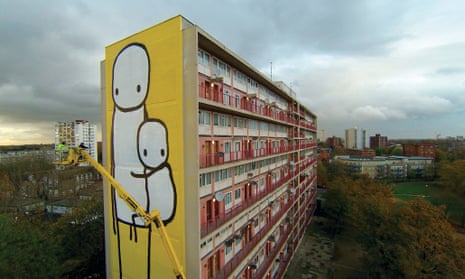‘This piece is called Art Thief,” says the street artist known as Stik. It’s a searingly hot day in Shoreditch, east London, and we’re standing outside his old studio on Pitfield Street. Painted on the door, one of his distinctive black-and-white figures carries another under its arm. “In a way, that’s me carrying off the artwork,” Stik explains. “I had a policy that I never sold any art, and then I did, and it changed. I wrestle to maintain some sort of purity.”
Stik is a garrulous, upbeat, youthful-looking character, who says he is “almost middle-aged”. His identity isn’t exactly a secret (“I’m no Scarlet Pimpernel”), but he politely withholds even basic biographical details: “I’m Stik now.” His street art is not for sale, but he survives by selling studio pieces and, now, a handsome coffee-table retrospective documenting his work since 2003. “I’ve been climbing the biggest walls in the city to put up these paintings and I’ve escaped relatively unscathed,” he says, grinning. “But putting this book together, I’ve had RSI in my wrist, a crick in my neck and a few panic attacks. It’s been an emotional journey, reliving the last decade.”

Touring Shoreditch with Stik is like having x-ray vision. You see things you would otherwise miss. In recent years he has worked in New York, Jordan, Norway and Berlin, but still feels an unbreakable bond with east London, which he came to know intimately while spending several years in homeless shelters. “I see the city in 3D, as a network of buildings and alleyways and access points,” he says. “I can’t stop seeing building as opportunities. I used to be interested in the insides; now I’m interested in the outsides.”
We turn into Hoxton Square. “This is where a lot of artists used space that nobody else wanted to use,” he says. “We made it cool and now it’s hard for us to stay here.”

Stik’s style was born of necessity: the monochrome scheme because it required only a black spray can and some discarded white house paint; the simplicity because “six lines and two dots was the quickest way to draw a human figure without getting caught”. Their expressive agility, drawing on classical composition, stems from his experience as an artist’s life model.
Stik’s art began as pure personal expression (“I felt invisible and it was my way of showing I’m here”) but evolved into “a small-p political” commentary on the changing face of London. Whereas Banksy’s stencils represent Banksy’s worldview, Stik’s figures are meant to speak for the community. When he accepts commissions (“Permissions,” he corrects. “Anything that’s visible from the street I do for free”), he asks local residents how they feel about their neighbourhood. Even with his guerrilla street art, he seeks permission from the locals – “or implied indifference, at least”. Stik thinks that a surprising number of his pieces have survived without being painted over because he’s discerning about what and where to paint. “Street art isn’t just art put out into the street,” he says. “It’s responding to the landscape. If a piece could be anywhere then what’s the point? The more integrated with the cityscape they are, the more they seem to belong there.”

We pause on Old Street, outside an empty building that was once a vibrant bar and art space called The Foundry. “I used to clean the toilets,” he says. “Then I sold a couple of pieces, quit the toilet-cleaning job and started making art for a living.” The Foundry was closed in 2010 to make way for a hotel; construction still hasn’t begun. High up on a wall, one of Stik’s figures gazes accusingly at a blank space.
Stik explains his work in various contexts: psychogeography, the tradition of community murals and the battle between private and public space. His most famous piece is a 125ft mural (Britain’s largest) of a mother and baby on the side of Charles Hocking House in west London, a tower block scheduled for demolition next year. Big Mother represents the residents while chiding the inhabitants of the luxury flats springing up around it. “I won’t get any more commissions from Ealing council, that’s for sure,” he says. “The figures that I draw are representing marginalised communities and have a certain dispossessed feeling about them.”

As we walk back to his current studio, a rough-and-ready loft containing spray cans, paint pots, canvases and maquettes, Stik wonders if the London he knows can survive relentless gentrification.
“Maybe they’re winning,” he says, allowing his optimism to sag for a moment. “I think there’s space for everyone but I’ve got a feeling they’d rather we weren’t here.” For now, Stik’s doleful, defiant figures are an emblem of resistance, symbolising Londoners who refuse to be rendered invisible. “The attitude I want to get across in my work is: ‘People live here’,” he says. “It’s our city.”

Comments (…)
Sign in or create your Guardian account to join the discussion